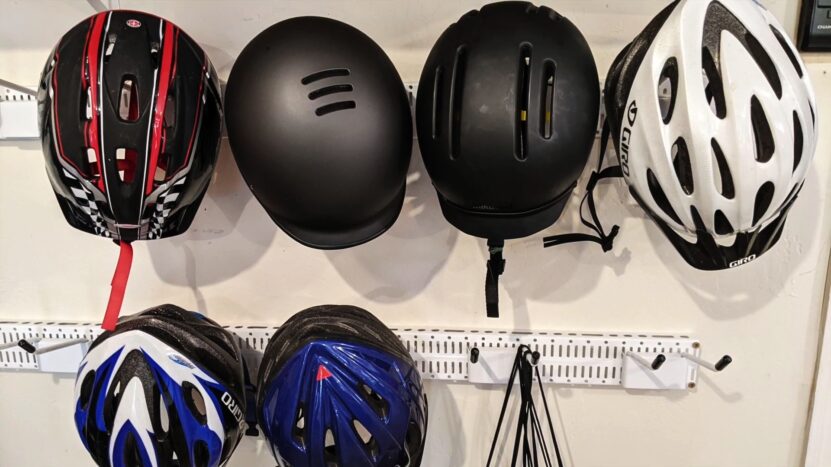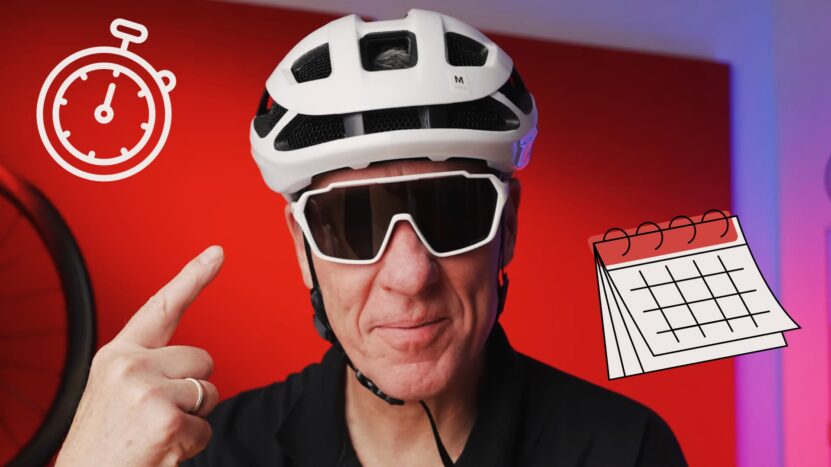Bike helmets are made from expanded polystyrene foam, which is covered with a thin layer of polycarbonate. This combination makes bike helmets very effective at absorbing impact and protecting your head in the event of a crash.
In this article, we will take a closer look at the average lifespan of bike helmets, how to prolong it, and when to know it’s time to replace them.
Do Bike Helmets Expire?
Yes, Bike helmets do expire. When a bike helmet expires, the polystyrene foam begins to break down and degrade. This degradation can reduce the helmet’s ability to protect your head in a crash.
Additionally, the straps and other parts of the helmet may also degrade over time. For these reasons, it’s important to replace your bike helmet every five to seven years. However, if your helmet has been involved in a crash, it should be replaced immediately.
Over time, the polystyrene foam can break down and become less effective at absorbing impact. The polycarbonate shell can also become cracked or damaged. This is why bike helmets have an expiration date. Most bike helmets will last for five to ten years.
However, it is important to note that the expiration date is only a guideline. If your bike helmet is not damaged and shows no signs of wear and tear, then it is likely that it will still provide adequate protection.
It is important to inspect your bike helmet regularly for any signs of damage. If you notice any cracks, dents, or other damage, then it is time to replace your bike helmet.
Bike Helmet Usage

Most cyclists know that wearing a helmet while riding is important, but many still don’t take the time to strap one on before heading out. Bike helmets can protect riders from serious head injuries in the event of a fall or collision, and they should be worn every time you ride.
Wearing a helmet is especially important for children. According to the Centers for Disease Control and Prevention (CDC), Bike helmets can reduce the risk of head injury by up to 85 percent.
Injuries to the head are the leading cause of death in bicycle accidents, so it’s vital that all riders wear helmets. If you’re not sure how to choose the right helmet, look for one that fits snugly and is certified by the CPSC. Bike helmets should be replaced every five years or after a major impact.
When used correctly, bike helmets can save lives. Make sure you and your loved ones are always protected by wearing a helmet on every ride.
Bike Helmet Handling
Bike helmets are important safety gear for cyclists, and proper handling can help prolong their life.
Here are some tips for proper bike helmet handling:
- Store your helmet in a cool, dry place out of direct sunlight.
- When not in use, keep your helmet clean and free of dirt, dust, and debris.
- Inspect your helmet regularly for signs of wear and tear, and replace it if necessary.
- Never store your helmet in a car or other hot environment, as this can damage the helmet.
Bike Helmet Storage

There are a few different ways that you can store your bike helmet when not in use. Here are a few options to consider:
Hang it on a hook
You can purchase a special hook designed specifically for bike helmets, or you can use any other type of hook. Just make sure the hook is mounted securely so that your helmet doesn’t fall and become damaged.
Put it in a bag
If you don’t want to put any holes in your walls, you can store your helmet in a bag. This is also a good option if you need to transport your helmet with you. Just make sure the bag is big enough to fit your helmet, and that it has a secure closure.
Use a shelf
If you have a shelf in your home or garage, you can use that to store your helmet. Just make sure the helmet is securely fastened so that it doesn’t fall off and become damaged.
Scientific Study
A bike helmet scientific study was recently conducted in order to explore the efficacy of wearing a bike helmet. The study found that cyclists who wore a helmet were significantly less likely to suffer a head injury in the event of an accident.
Additionally, cyclists who wore a helmet were also more likely to recover from their injuries more quickly than those who did not wear a helmet. While the study’s results are encouraging, it is important to remember that no one Bike Helmet can completely protect you from all injuries.
Bike helmets are just one piece of safety equipment that can help reduce your risk of injury in the event of an accident.
When Should You Replace A Bike Helmet?
Your bike helmet is designed to protect your head in the event of a fall or collision. But over time, even the best helmet can become worn and brittle, decreasing its ability to do its job. So when should you replace a bike helmet?
There are a few things to keep in mind when determining whether it’s time for a new helmet. First, if you’ve been in a crash, it’s time for a new helmet – even if there’s no visible damage to the helmet itself.
Second, check the expiration date on your helmet. Most helmets have a lifespan of about 5 years from the date of manufacture. After that, the materials start to break down and lose their efficacy.
Finally, take a close look at your helmet for signs of wear and tear. If the straps are fraying or the foam is cracked or misshapen, it’s time to replace it.
The Five-Year Rule
Bike helmets are an important safety device that can protect riders from serious head injuries. However, it is important to note that bike helmets have a limited lifespan and should be replaced every five years.
Bike helmets are made from a variety of materials, including polystyrene foam, which is designed to absorb impact in the event of a crash.
Over time, these materials can degrade and become less effective at protecting riders from serious head injuries. For this reason, it is important to replace bike helmets every five years.
The Ten-Year Rule

The ten-year rule of bike helmets means that you should replace your bike helmet every ten years, regardless of whether or not it has been involved in an accident. The reason for this is that over time, the materials in the helmet can break down and become less effective at protecting your head in a crash.
So, if you’ve had your helmet for more than ten years, it’s time to replace it with a new one. And, if you’re not sure how old your helmet is, it’s always better to err on the side of safety and get a new one
What Manufacturers Say
Bell: “Your Bell helmet should be replaced every five years. Even if it hasn’t been involved in a crash, it’s exposed to UV rays and other elements that can degrade the material and affect its performance.”
Giro: “The useful life of a helmet is dependent on many factors, including the type of use, frequency of use, and care and maintenance. In general, the more you use your helmet, the sooner you should replace it.
We also recommend that you replace your helmet every three to five years regardless of how often you use it.”
Specialized: “We recommend replacing your helmet every three years. The foam material in helmets will compress over time, which affects how well the helmet absorbs impact in a crash.”
Should You Replace A Bike Helmet After An Accident?
If you were involved in a minor crash where you did not hit your head or suffer any other injuries, then it is probably okay to keep using your existing helmet.
However, if the accident was more serious and you hit your head, even if you did not suffer any obvious injuries, it is still best to replace your helmet.
Does Dropping A Helmet Ruin It?
If the helmet is dropped on a hard surface, like concrete, there is a good chance that it will be damaged. The impact can crack the helmet’s shell or damage the inner liner.
If the helmet is dropped on a softer surface, like grass, there is a much lower chance of damage.
If you do drop your helmet, it’s important to inspect it for any damage before using it again. Look for cracks in the shell or any other damage to the helmet. If you find any damage, replace the helmet immediately.
What Features To Look For When Buying A Replacement Bike Helmet
Size & Shape
The most important factor is the fit. A helmet should fit snugly on your head, without being too tight or too loose.
You should also make sure that the helmet covers your entire head, including your forehead.
The next factor to consider is the shape of the helmet. Helmets come in a variety of shapes, including oval, round, and aerodynamic. The best way to determine which helmet shape is right for you is to try them on and see what feels most comfortable.
Multidirectional Impact Protection (MIPS)
Multidirectional Impact Protection (MIPS) is a type of helmet technology that can provide an additional level of protection in the event of a fall or collision.
MIPS helmets are designed to reduce the risk of brain injury by reducing the rotational forces that can occur during an impact. MIPS helmets are available in a variety of styles and sizes to suit different needs.
If you are considering an MIPS helmet, it is important to choose one that fits properly and is comfortable to wear. You should also make sure that the helmet you select is appropriate for the activity you will be participating in.
Chin Strap
Chin straps are an important part of any helmet, as they help to keep the helmet securely in place on your head. There are a variety of different chin strap designs available, and the best one for you will depend on your personal preferences.
Some of the most popular chin strap designs include the Ratchet Chin Strap, the Click-to-Fit Chin Strap, and the Magnetic Chin Strap.
Ventilation

Wearing a helmet is important for safety while riding a motorcycle. However, it is also important to make sure that the helmet is properly ventilated. Otherwise, the rider may experience discomfort or even heat stroke.
There are several ways to ventilate a helmet. The most common method is to use vents that are built into the helmet. These vents allow air to flow through the helmet and keep the rider’s head cool.
Another way to ventilate a helmet is to use a fan. This can be either a stand-alone fan that attaches to the helmet or a battery-operated fan that is built into the helmet. Fans help to circulate air and keep the rider’s head cool.
Finally, some riders choose to wear a bandana or scarf under their helmet. This helps to absorb sweat and keep the rider’s head cool.

